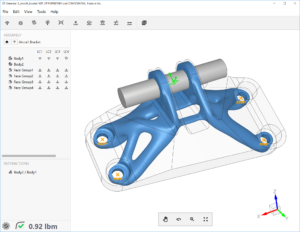Two makers of engineering software announced in late November acquisitions that will help them further their technology offerings through the addition of generative design, artificial intelligence, and digital blueprints.
PTC, of Needham, Mass., acquired Frustum, a maker of generative design software, this month. Frustrum’s software makes use of artificial intelligence to generate design options. It will add generative design capabilities to the PTC Creo portfolio, said Jim Heppelmann, PTC’s president and chief executive officer.
“With breakthrough new technologies such as augmented and virtual reality, high-performance computing, Internet of Things, artificial intelligence, and additive manufacturing entering the picture, the CAD industry is going through a renaissance period, Heppelmann said.
Frustum, of Boulder, Colo., complements PTC’s relationship with Ansys, which will bring analysis to the start of the design process, he said.
With embedded Frustum capabilities as well as those from analysis maker Ansys, Creo will be able to recommend design approaches using generative design, guide the user through the iterative design process using the Ansys Discovery Live feature, and, ultimately validate the full product design at scale using the broader ANSYS Discovery suite, he said.

Integral to Frustum’s technology is a powerful AI component that learns, evolves, and performs key tasks, including:
- Providing feedback to a designer early in the design phase.
- Optimizing designs for multiple objectives simultaneously and offering a designer with multiple novel design alternatives, which enables companies to reduce engineering cycles.
- Modifying designs to manage multiple requirements and constraints, physics, materials availability, manufacturing processes, and design objectives.
- Automating testing the outcomes of the design with other enterprise insights, including costing, supply chain, and quality data.
Meanwhile, generative design is appealing to PTC’s vast customer base, Heppelmann said, as they seek ways to:
- Increase engineering productivity.
- Improve innovation and conceptual design exploration.
- Develop higher-performance designs that are lighter weight, with improved durability.
- Optimize new products for improved manufacturability, reduce material costs, and decrease manufacturing cycle times.
- Create complex geometries optimized for additive manufacturing.
- Deliver better products faster.
Also in late November, Autodesk announced plans to acquire PlanGrid, of San Francisco, which helped move blueprints from paper to the iPad when it launched in 2011.
The move is intended to help Autodesk, which also makes construction and architectural software, digitize construction, which fits with the company’s vision of digitizing design in general, said Andrew Anagnost, the company’s chief executive officer.
“There is a huge opportunity to streamline all aspects of construction through digitization and automation. The acquisition will accelerate our efforts to improve construction workflows for every stakeholder in the construction process,” he said in a statement.
In an interview in 2015, Tracy Young, PlanGrid’s chief executive officer and co-founder, she said the industry was ripe for change.
“The heart of construction is just a lot of construction blueprints information. It’s all tracked on paper right now and they’re constantly, constantly changing,” Young said.
Those manual changes often resulted in errors she said, and that was costly for the contractors. As an engineer working for a construction company, who was at one time responsible for making the paper copies, she recognized that the process could be improved by moving it into the digital realm.


Leave a Reply
You must be logged in to post a comment.